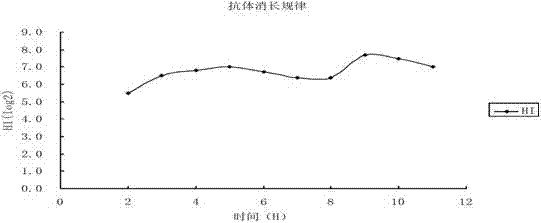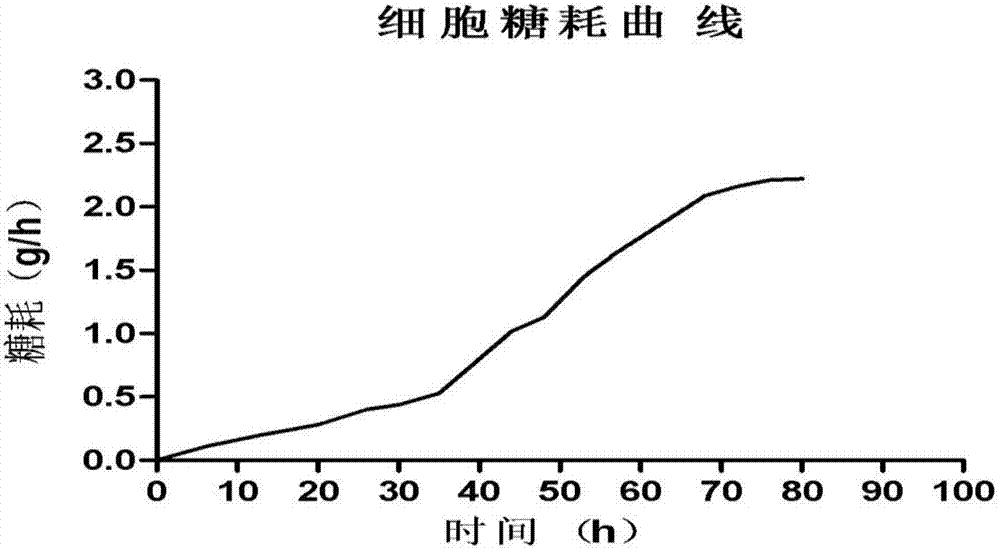Method for large scale cultivation in bioreactor
A large-scale culture and bioreactor technology, which can be quickly adapted to the field of MDCK cell culture within 5 generations of recombinant H5N1 avian influenza virus, can solve problems such as the inability of cultured virus titers to meet vaccine production, and achieve easy industrialized large-scale operation, cell Rapid proliferation and good virus immunogenicity
- Summary
- Abstract
- Description
- Claims
- Application Information
AI Technical Summary
Problems solved by technology
Method used
Image
Examples
Embodiment 1
[0024] Example 1: Recombinant H5N1 avian influenza virus strain rC4 / W1 strain rapidly adapted to MDCK cells
[0025] rC4 / W1 strain (see Genetic Resources Table): This virus is a fully avian-derived H5 subtype avian influenza virus. It is preserved in the China Center for Type Culture Collection with the preservation number: CCTCC NO: V201029. The steps for its rapid adaptation to MDCK cells are as follows :
[0026] 1) One MDCK cell was grown into a dense monolayer T75 cell flask, and the cells were digested and evenly spread into three 6-well cell culture plates.
[0027]2) Chicken embryo allantoic fluid venom is diluted to 10 times with 10 times ratio -6 .
[0028] 3) Take 10 -3 、10 -4 、10 -5 、10 -6 Each dilution of venom was 200ul, supplemented to 3ml with cell maintenance solution, and added to a 6-well plate full of MDCK cell monolayers, each dilution concentration was repeated, and 200ul of the dilution was supplemented to 3ml with cell maintenance solution, and ad...
Embodiment 2
[0035] Example 2: Rapid Adaptation of Recombinant H5N1 Avian Influenza Virus Strain XN / PR8 (See Genetic Resources Table) to MDCK Cells
[0036] 1) One MDCK cell was grown into a dense monolayer T75 cell flask, and the cells were digested and evenly spread into three 6-well cell culture plates.
[0037] 2) Chicken embryo allantoic fluid venom is diluted to 10 times with 10 times ratio -8 .
[0038] 3) Take 10 -4 、10 -5 、10 -6 、10 -7 、10 -8 Each dilution of venom was 200ul, supplemented to 3ml with cell maintenance solution, and added to a 6-well plate full of MDCK cell monolayers, each dilution concentration was repeated, and 200ul of the dilution was supplemented to 3ml with cell maintenance solution, and added to a long A monolayer full of MDCK cells was used as a negative control.
[0039] 4) At 37°C, remove the virus solution after virus adsorption for 1.5 hours, wash the MDCK cells with virus dilution solution for 3 times, add 3ml of cell maintenance solution to eac...
Embodiment 3
[0045] Example 3: Recombinant H5N1 avian influenza virus strain XN / W1 rapidly adapts to MDCK cells
[0046] The XN / W1 strain (see Genetic Resources Table) belongs to the whole bird-derived H5 subtype avian influenza virus. The steps of its rapid adaptation to MDCK cells are as follows:
[0047] 1) One MDCK cell was grown into a dense monolayer T75 cell flask, and the cells were digested and evenly spread into three 6-well cell culture plates.
[0048] 2) Chicken embryo allantoic fluid venom is diluted to 10 times with 10 times ratio -6 .
[0049] 3) Take 10 -3 、10 -4 、10 -5 、10 -6 Each dilution of venom was 200ul, supplemented to 3ml with cell maintenance solution, and added to a 6-well plate full of MDCK cell monolayers, each dilution concentration was repeated, and 200ul of the dilution was supplemented to 3ml with cell maintenance solution, and added to a long A monolayer full of MDCK cells was used as a negative control.
[0050] 4) At 37°C, remove the virus solutio...
PUM
 Login to View More
Login to View More Abstract
Description
Claims
Application Information
 Login to View More
Login to View More - R&D
- Intellectual Property
- Life Sciences
- Materials
- Tech Scout
- Unparalleled Data Quality
- Higher Quality Content
- 60% Fewer Hallucinations
Browse by: Latest US Patents, China's latest patents, Technical Efficacy Thesaurus, Application Domain, Technology Topic, Popular Technical Reports.
© 2025 PatSnap. All rights reserved.Legal|Privacy policy|Modern Slavery Act Transparency Statement|Sitemap|About US| Contact US: help@patsnap.com



